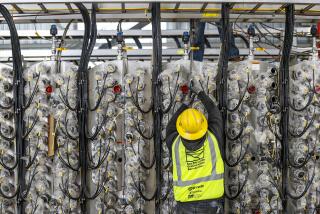Water Board Finally Has Solution to Huge Toxic Spill : Pollution: A miles-long chemical mess underneath Irvine will be cleaned up by a state-of-the-art system. But the county and the Marine Corps are still arguing over the bill.
- Share via
IRVINE — A $1.1-million system to remove a huge underground chemical spill was unveiled Friday by county water officials after five years of frustration, negotiation and costly investigations.
The first of its kind in the nation, the ground-water cleanup system will pump out 1 million gallons of contaminated water a day from underneath Irvine and cleanse it of trichloroethylene, or TCE, a suspected cancer-causing chemical.
The project--which has pitted local water officials against the U.S. Marine Corps--has been one of the most contentious and longest-running efforts to resolve a water-pollution problem in Orange County history.
William Mills, general manager of the Orange County Water District, which has overseen the project, said he is relieved that the area’s water supply is finally being protected, especially during California’s long drought.
But the water agency and state environmental agencies remain convinced that the money should have come from the Marine Corps, not from county water users and the city of Irvine. The Marines, however, remain unconvinced that their base in El Toro, which is on the federal Superfund list of the nation’s worst toxic sites, is the sole source of the chemical.
The underground spill--which apparently stretches for three miles and is the largest every pinpointed in the county--has been moving toward nearby wells that provide drinking water.
The project is one of six innovative systems that the OCWD will launch by 1992 to clean up millions of gallons of Orange County ground water contaminated by a variety of sources, ranging from old agricultural runoff to industrial chemicals.
The new facility unveiled Friday in an orange grove near the corner of Irvine Center Drive and Jeffrey Road is pumping out the contaminated water and stopping it from spreading. The water will be used to irrigate Irvine landscaping and crops.
The water is being removed by a well, then routed through a system using a technology called rotary aeration that spins the water and removes the TCE. Air is then blown through the system, and subjected to an ultraviolet and oxidizing process that converts the TCE to carbon dioxide and water.
No other plant in the United States combines these water- and air-purifying technologies, according to William Salomons, a consultant for Ecolo-Flo, the system’s designer. The new technology will probably soon be used throughout the nation to clean up polluted water, he added.
Originally, the water agency planned last year to use the TCE-tainted water for agricultural fields without removing the chemical because it posed minimal risk to residents. But the Irvine City Council was adamant about removing the pollutant first, and the city provided OCWD $450,000 in capital and $30,000 in annual operating expenses.
No mention was made during Friday’s ceremony about the long conflict between the Marine Corps and water officials, but speakers did allude vaguely to the years of roadblocks.
The cleanup project has been “subject to a lot of sources of frustration,” said Jerry Thibeault, executive officer of the Santa Ana Regional Water Quality Control Board, the arm of state government responsible for enforcing water-pollution laws.
“This effort to identify a responsible party has been and will continue to be a pretty slow process,” he said.
In 1985, OCWD discovered the chemical in two Irvine wells that provide irrigation water for crops. The wells are next to the El Toro Marine Corps Air Station, and the water quality board issued a cleanup order to the Marines.
But several years of negotiations failed to persuade the Marine Corps to clean it up, so the OCWD board decided to act because it feared that the spill jeopardized millions of dollars’ worth of Orange County’s drinkable water.
Marine Corps officials agree that the chemical leaked from the air station, but they maintain that there is inadequate proof that all the TCE under Irvine seeped from their base. TCE is a solvent that was widely used for cleaning engine parts until it was discovered to be a carcinogen.
Marine Col. Jack Wagner said Friday that the resolution is now in the hands of the federal Environmental Protection Agency.
More to Read
Sign up for Essential California
The most important California stories and recommendations in your inbox every morning.
You may occasionally receive promotional content from the Los Angeles Times.










